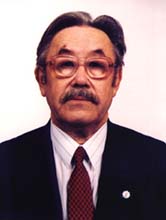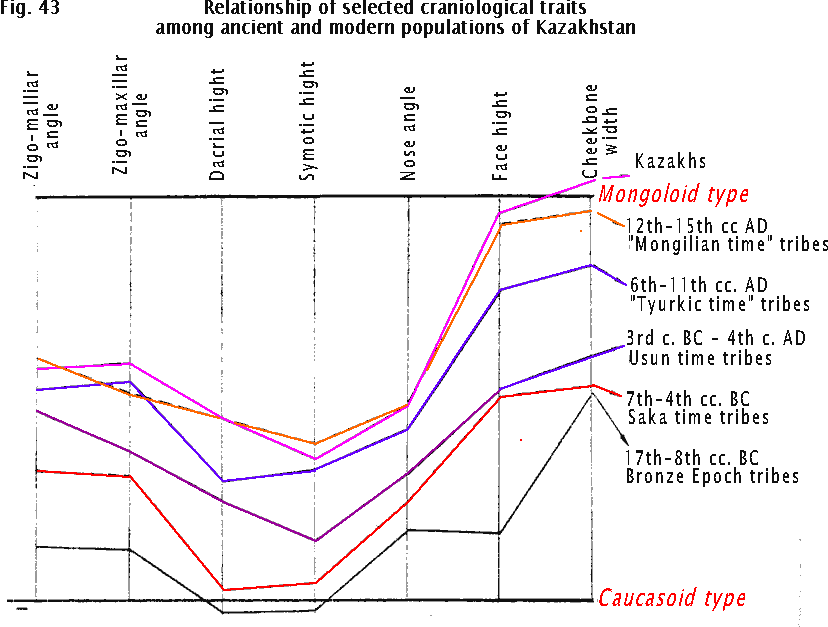|
Home Back In Russian Genetics - Index Archeology - Index |
Sources Roots Tamgas Alphabet Writing Language |
Genetics Geography Archeology Religion Coins Wikipedia |
Genetics: Blood Types Genetics: Lingo-Ethnical Tree Scytho-Siberian Genetics Eastern Hun Genetics |
Ethnic Affiliation Scythians Scythians 7 c. BC Pazyryk 4-2 c. BC Burial place of a Massagetan warrior 8-7 c. BC Scythians and their descendents |
Alan Dateline Avar Dateline Besenyo Dateline Bulgar Dateline Huns Dateline Karluk Dateline |
Karluk Dateline Khazar Dateline Kimak Dateline Kipchak Dateline Kyrgyz Dateline Sabir Dateline |
||||||||
|
||||||||||||||
|
||||||||||||||
|
Foreword |
||||||||||||||
|
It was a long and tedious road of Dr. O.Ismagulov book to get to a simple conclusion: Over the last 3,000 years the initial Andronovo population did not move. Over 3,000 years the Andronovo population was consistently gaining an admixture of the Mongoloid component, gradually reducing the Andronovo Caucasoid type and gaining Mongoloid genes. And also the genes of their other neighbors, guests and invaders. This global picture across a giant area in the Asia steppe belt again and again appeared in archeological excavations, frequently surprising naive archeologists who keep adhering to the racio-lingual concepts promulgated in the 19th century. The genes did not move, they developed in time, mixing, absorbing, and gradually changing in the direction of a general trend. This underlying picture does not exclude a linguistic change. Neither does it provide a slightest evidence of such a change. We just do not know, and may never know, unless textual evidence can be found that would attest a linguistic switch from one language family to another, a very unlikely event considering that writing is a relatively late invention. By the time writing could leave its traces in Kazakhstan, the Andronovo civilization already had a 1,500-year history, and following the same elite dominance linguistic theories that advocate a Middle Asian linguistic switch, that civilization had at least three full timeframe opportunities to do so before the appearance of any writing. That is especially so, recognizing a profound absence of a dominant center, and superb mobility of subjugable candidates, their dispersion, and close-knit nature of their societies. A sane assessment of a chance to change the Andronovo language, dispersed over 5,000 km, carried by tight-knit core nucleoli of 1,000 people separated by a couple of days mounted trip from another nearest nucleoli, and who may spend together with the rest of the clan just a winter season, can kill any idea devised for sedentary populace in a cabinet heated by subdued orderlies. Based on O.Ismagulov' study, any cabinet dweller looking at today's Kazakhs, will see an Andronovo face with a slight admixture of historical sediments. Save on travel expenses, just look at Dr. O.Ismagulov himself. |
||||||||||||||
CONCLUSION |
||||||||||||||
|
|
||||||||||||||
|
|
||||||||||||||
|
146
Based on paleoanthropological and craniological research of the Kazakhstan population from 17th-8th centuries BC
(Early Bronze period of
Andronovo Culture is 18th - 16th cc. BC)
to the modernity, we came to these conclusions.
Anthropologically modern Kazakhs possess clearly expressed
mixed features, between them can be discerned two components,
Caucasoid and Mongoloid. The
first, Caucasoid type, is local, it is represented by ancient Kazakhstan tribes of
17th-8th centuries BC (Bronze Epoch).
From that substrate developed the later population. The local racial type
was prevailing among the aboriginal inhabitants until the second
millennium of our era, and in the subsequent period it remained one of the main components in
anthropological composition of the Kazakhstan modern population. Thus, the anthropological data allows to establish
a strong genetic connection between the morphological
features of modern Kazakhs and the complex of morphological
attributes observed in the composition of the Kazakhstan population during the
17th-8th centuries BC (Bronze Epoch). In the anthropological shape of the modern Kazakhs is also noticeable the influence of a racial attributes gene from the Central Asian newcomer groups, traces of which are distinctly delineated from the Saka period till the late Middle Ages. A persisting inflow of the Mongoloid tribes' gene undoubtedly left a deep trace in the anthropological composition of indigenous population in Kazakhstan. However, the infiltrating racial groups not were numerically overwhelming. As a result the process of a mestization flowed without abrupt displacements or absorptions, i.e. without notable replacement of local ethnic groups by newcomer tribes from Central Asia, which can be assessed by the pace and direction of craniological attributes change in time. If our suggestion is correct, the distinctive character of anthropological type of Kazakhs coalesced and developed mainly on the substrate of the ancient Kazakhstan Caucasoid race in a prolonged contact with newcomer Mongoloids.
Thus, the anthropological analysis of the ancient and
modern population of the territory found many important
aspects for understanding of an origin and ethnic history
of the Kazakh people, which were obscure before the development
and study of paleoanthropological and craniological data in
Kazakhstan. An effective utilization of anthropological
materials as a historical source for study of the
ethnogenesis of the Kazakh people requires a further extensive
research mainly in somatology, dermatoglify, odontology,
osteology and a complex of biochemical properties of
the blood groups of Kazakhs. APPENDIX
SOME SERIES OF SKULLS OF THE OLD AND MODERN POPULATION OF
KAZAKHSTAN |
||||||||||||||
|
||||||||||||||
|
Home Back In Russian Genetics - Index Archeology - Index |
Sources Roots Tamgas Alphabet Writing Language |
Genetics Geography Archeology Religion Coins Wikipedia |
Genetics: Blood Types Genetics: Lingo-Ethnical Tree Scytho-Siberian Genetics Eastern Hun Genetics |
Ethnic Affiliation Scythians Scythians 7 c. BC Pazyryk 4-2 c. BC Burial place of a Massagetan warrior 8-7 c. BC Scythians and their descendents |
Alan Dateline Avar Dateline Besenyo Dateline Bulgar Dateline Huns Dateline Karluk Dateline |
Karluk Dateline Khazar Dateline Kimak Dateline Kipchak Dateline Kyrgyz Dateline Sabir Dateline |
||||||||
| © |
| 6/30/06 ©TürkicWorld |

